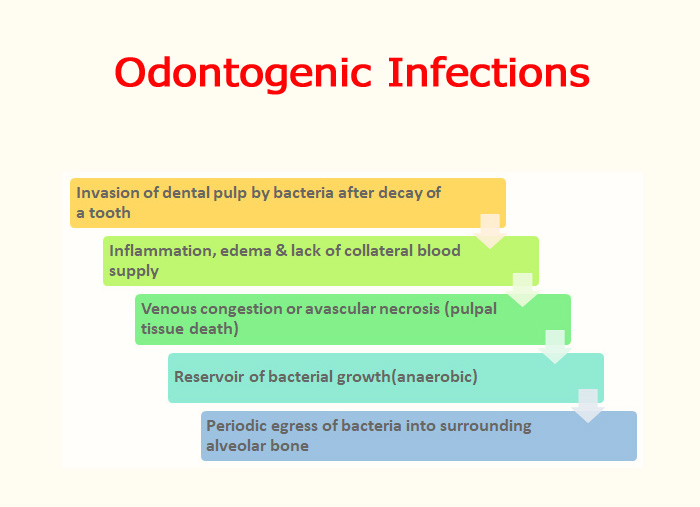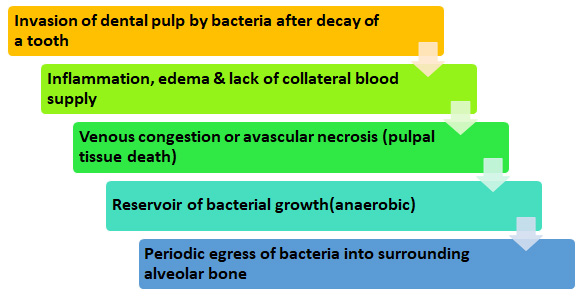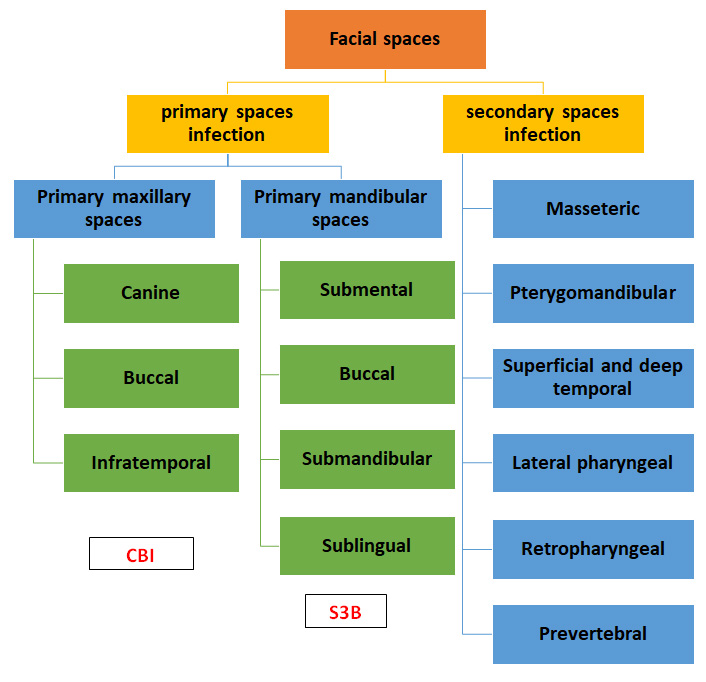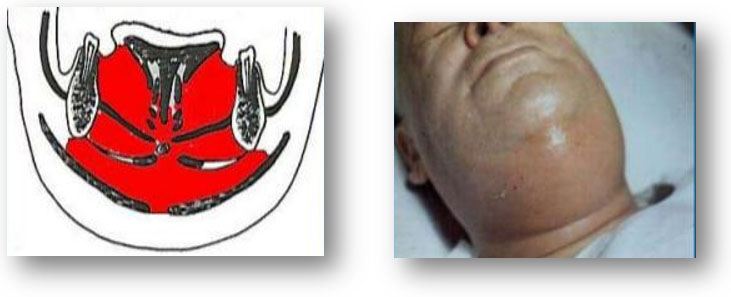- NEED HELP? CALL US NOW
- +919995411505
- [email protected]

CAUSES
- Pulp disease
- Periodontal disease
- Secondarily infected cyst & odontomes
- Remaining root fragment
- Pericoronal infection
MICROBIOLOGY
- Aerobic gram positive cocci bacteria- streptococci milleri, strep. Sanguis, strep. Salivarius, strep. Mutans.
- Anaerobic Cocci-p
- Bacteriodes-porphyromonas, prevotella
PATHWAYS OF ODONTOGENIC INFECTIONS

- Odontogenic infections progress through 3 stages: inoculation, cellulitis and abscess . Sinus tract/fistula may be seen in neglected cases
a. By direct continuity via the tissue
b. Via the lymphatics into the regional lymph nodes and subsequently into the blood stream
c. Haematogenous spread leading to thrombophlebitis, bacteremia or septicemia. Thrombus may propagate along the veins, entering the cranial cavity via emissary veins to produce cavernous sinus thrombosis
FACIAL SPACES INFECTIONS
Sometimes, infection may spreads towards the facial spaces, forming serious abscesses called facial space infection.

PRINCIPLES OF TREATING INFECTION
1 - Proper knowledge of anatomy, anatomical landmarks and vital structures of the face and neck is necessary to predict pathways of spread of infections and to drain these spaces2 - Remove the cause (i.e. extract the tooth, open & extirpate the pulp)
3 - Incision & Drainage
For intraoral abscess, stab incision is done through the mucosa down deep to the underlying bone. Incisions for extra-oral abscesses should be placed in a skin crease to leave the least evident scar. Once the skin incision is made, blunt evacuation of pus might be done using a curved haemostat. The abscess cavity should be kept open to allow continuous drainage.
4 - Antibiotics
Cellulitis
- if abscess is NOT able to establish drainage through the surface of skin or into oral cavity
- may spread diffusely through facial planes of soft tissue
- acute + edematous spread of acute inflammatory process
Ludwig's Angina
- is a massive indurated brawny cellulites, occurs bilaterally in the submandibular, sublingual & submental spaces. Infection is propagated by lymphatic spread or directly through submandibular space. Cellulitis is then rapidly spread to involve bilaterally the parapharyngeal and pterygoid spaces
- Clinically, the condition is characterized by:
- Painful bilateral swelling of floor of mouth and elevation of tongue.
- Bilateral firm, brawny painful, diffuse swelling of upper part of neck
- Difficulty in swallowing and breathing
- Rapid pulse, high fever, fast respiration
- Leucocytosis
- Patient should be hospitalized. Conservative treatment includes intravenous antibiotic therapy and close airway observation . Pus is evacuated, when indicated, by through & through drainage

Cavernous sinus thrombosis
Infections may spread via hematogenous route to the cavernous sinus occurs from:1- Anteriorly:
a) Superior labial venous plexus to
b) Anterior facial vein, then via
c) Superior or inferior ophthalmic vein into the cavernous sinus
2- Posteriorly: from retromandibular vein to the ptrygo- mandibular venous plexus, the emissary vein passing through foramen ovale, spinosum, to cavernous sinus
3- Superior petrosal sinus (inside the ear)
Osteomyelitis
- is an infection and inflammation of the bone or the bone marrow. It can happen if a bacterial or fungal infection enters the bone tissue from the bloodstream, due to injury or surgery.
- The incidence of osteomyelitis is much higher in the mandible due to the dense cortical bone that prevents the penetration of periosteal blood supply, and the inferior alveolar artery is the only supply to the mandible. It is much less common in the maxilla due to the excellent blood supply from number of different arteries. In addition the maxillary bone is much less dense than the mandible
- Classification:
- Acute suppurative
- Subacute
- Chronic suppurative
- Rarely, a sclerotic nonpurulent form of osteomylitis
- Radiographic features: The appearance of “moth-eaten” bone or sequestrum of bone
- Treatment: sequestrectomy and saucerization
MCQs
1 . The first stage of a bacterial odontogenic infection is
A)abscess.
B)cellulitis.
C)necrosis.
D)inoculation.
Answer:D
Bacterial odontogenic infections progress through several stages of development. The first stage, inoculation, involves bacterial access to the facial spaces from the periapical region of necrotic teeth or from deep periodontal pockets. Aerobic bacteria predominate during this stage. The patient experiences minimal discomfort, and the overlying oral mucosa have a soft, doughy consistency on palpation.




